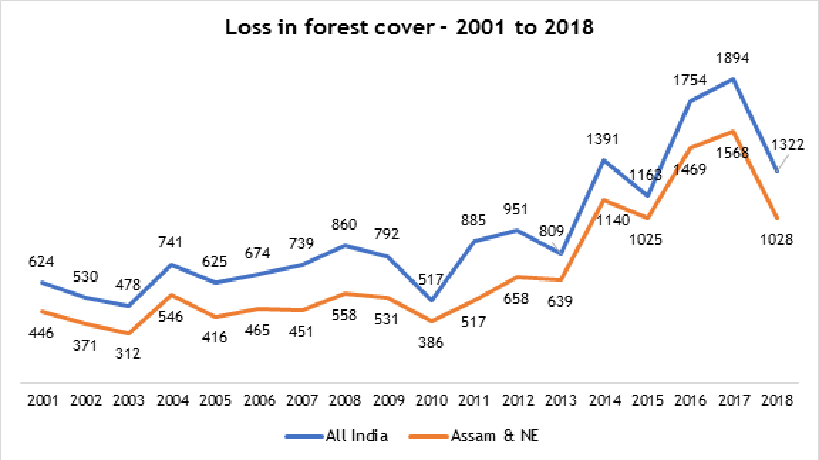From 2001 till 2018, loss of forest in India was to the effect of 16, 744 sq. km, according to the data from Global Forest Watch (GFW), a repository of forest data worldwide. Out of this, 12, 523 sq. km or almost 75% happened in Assam and the NE states.

source: Global Forest Watch
From 2001-2018, maximum loss of forest area has been in Assam – 2388.5 sq. kms while Mizoram has lost the maximum in the last 6 years (1392 sq. km)

source: Global Forest Watch
The North East – historically one of the greenest part of the country – is feeling the pinch. This May, Mizoram’s capital Aizawl recorded its highest temperature in the past 2 decades. For the last few years, the region is being hard hit by floods and landslides. While the flooding of the Brahmaputra has been a historical problem in Assam, environmental observers believe that the large-scale deforestation in the upper streams of the river is leading to the ferocity of the floods increasing every year. The state of Arunachal was recently cut-off from the rest of India due to devastating landslides. Researchers from the Indian Institute of Tropical Meteorology, Pune found out that the North-East, one of the wettest places on earth – has witnessed a drop of 25-30% in rainfall over the past 30 years.
An independent research conducted by researchers from University of Sheffield and University of York revealed that ~62% of the tropical rainforest area in the Indo-Malaya region (Indian subcontinent, Indo-China) – equating to ~10 million sq. kms has become “incapable” of providing pathways to wildlife species for cooler or favorable climate. The research attributes this rapid deforestation leading to disconnection of natural habitats of wildlife species. This can have a devastating impact on survival of thermally sensitive species in these forests.
According to data recently tabled in the Parliament, between 2015 & 2018, around 20,000 hectares of forest land has been used for developmental activities like mining, thermal power plants, dams, road & railways and irrigation projects. Deforestation for developmental activities is always a tricky and sensitive topic as the latter is essential to improve living standards of the population. However, if unchecked, mass scale deforestation can lead to unprecedented damage on the ecological balance of the country/region.
As per Government policy, development activity on forest land can be sanctioned on the provision of the money received in lieu of the same is utilized for afforestation activities. It is critical therefore for government agencies to monitor this most diligently to ensure that depletion of forest resources is minimized.
Earlier this week, the Tiger Census results brought a big cheer revealing a 33% jump in India’s tiger population since 2014. Yet there are some worrying signs amidst the good news. In the last 4 years, tiger habitat has shrunk by 20%. This explains the reduced presence of tigers outside tiger reserve forests. Also, 3 of the project Tiger Reserves – Buxa (WB), Dampa (Mizoram) and Palamu (Jharkhand) – had zero population of tigers. In the case of Buxa, wanton construction of tourist resorts inside core areas and consequently large-scale deforestation played a major role in the extirpation of resident tiger population. The 2019 tiger census report also places the north east hills in “Critically endangered” category from point of view of tiger conservation.
India has pledged to create an additional carbon sink of 2.5 billion tonnes to 3 billion tonnes of carbon dioxide equivalent through additional forest and tree cover by 2030 under the Paris Agreement on climate change, but the country’s flagship afforestation program, the Green India Mission (GIM), remains grossly underfunded. According to a parliamentary committee report, while GIM was proposed with an outlay of Rs 60,000 crores over 10 years, during 2017-18, Rs 47.8 crores was allocated. However, committed liability for 2015-16 and 2016-17 already stood at Rs 89.53 crores thus over-exceeding the budgetary allotment. The panel also found that during the previous 2 years, GIM missed its targets by 34%. To meet the 2030 Paris Agreement target, an additional 30 million hectare of land needs to be brought under forest cover. As of 2016-17, the committee’s report revealed only 51,387 hectares has been afforested.
The situation is quite grim today. Development of backward areas is a necessary step for the government but maintaining environmental balance while achieving development targets is a challenging task. However, as project Tiger showed recently, proper and planned implementation of strategies can yield spectacular results. IPD sincerely hopes a similar success story is also scripted on the forestation agenda.
Purposeful and well supported with data – small yet crisp writing . Apart from endangering tigers we are ruthless towards treating nature.
In nearby Kolkata the we have destroyed Sundarbans and the day is not far when we have to face huge shortage of drinking water and harsh climatic conditions. I had attended a talk by two environmental scientists from Kolkata who had said it would maximum take 10 years to face severe drinking water scarcity in Kolkata and adjoining areas if no alternatives taken or protect Sundarbans.
LikeLiked by 2 people
Given the situation TODAY, we will not be able to achieve the carbon sink target of the NDCs, no way.
And I agree with your point on the tiger census. Numbers don’t reveal the true picture. Habitat destruction and fragmentation is extremely worrying. Only recently, the Uttarakhand government wanted to construct a road corridor through the centre of the Jim Corbett National Park (this was thankfully withdrawn).
LikeLiked by 1 person